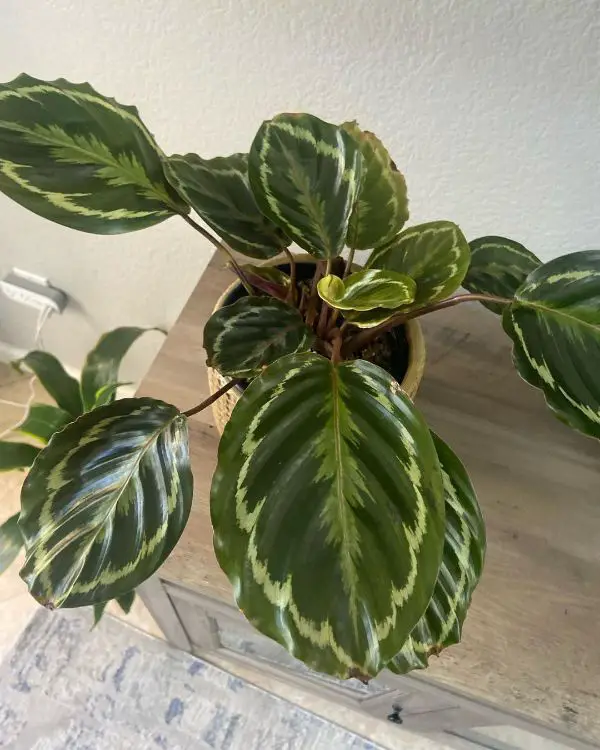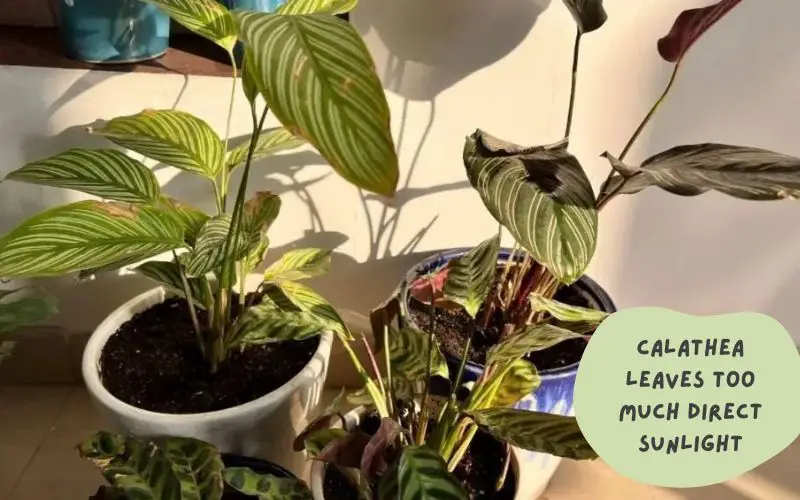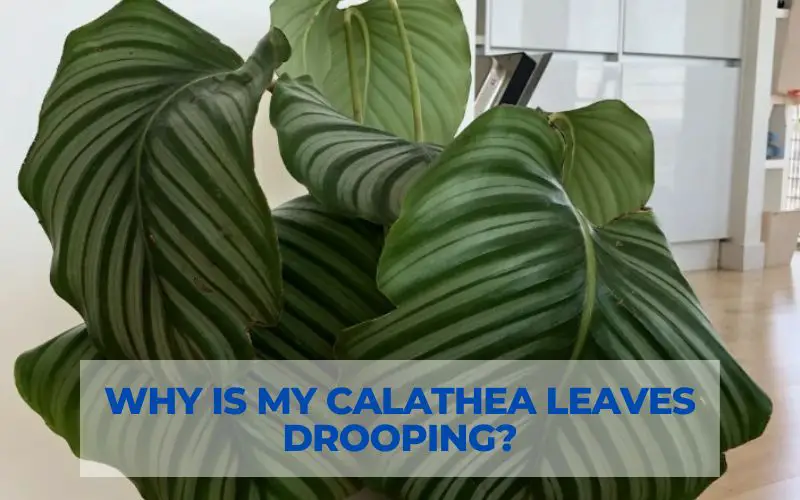This is a common issue with Calatheas, and there are a few things you can do to help perk them up again. In this post, we’ll take a look at what might be causing your Calathea leaves to droop, and we’ll give you some tips on how to fix the problem. Keep reading for more information
Causes of Calathea leaves drooping
If your Calathea leaves are drooping, it is likely due to one of several reasons. Here are 12 common causes to answer the question Why is my Calathea leaves drooping?
1. Lack of Water
One of the most common reasons for Calathea leaves drooping is lack of water. The leaves of Calathea plants are very thin and delicate, making them susceptible to damage from dehydration. When the soil around a Calathea plant becomes too dry, the leaves will start to droop in an attempt to conserve water.
If you see your Calathea leaves drooping, it’s important to water the plant immediately. Make sure to provide enough water so that the soil is evenly moistened, and avoid letting the plant sit in water.
2. Poor Quality Water
Any gardener will tell you that water quality is important for the health of your plants. Unfortunately, many people don’t realize that the quality of water can vary depending on the source. For example, water from a rain barrel or a garden hose is likely to contain more minerals than water from a tap.
This is because rainwater picks up minerals as it filters through the ground, and hose water can also be contaminated by the chemicals used to treat the water supply. As a result, Calathea leaves may droop if they are watered with poor-quality water.
Luckily, there are a few easy ways to improve the quality of your water. If you live in an area with hard water, you can use a water softener to remove minerals from your water. Alternatively, you can let your water sit for 24 hours before watering your plants, which will allow some of the minerals to settle out.

3. Overwatering
Overwatering is one of the most common reasons for Calathea leaves to droop. If the leaves are wilting and the soil is soggy, it’s a sure sign that your plant is getting too much water. The first step is to stop watering for a few days and let the soil dry out completely. Once the soil is dry, you can resume watering, but be sure to water only when the soil is dry to the touch.
If you suspect your plant is overwatered, remove it from its pot and inspect the roots. If they are white or mushy, it’s time to take action. Repot the plant in fresh, slightly moistened potting mix and make sure the pot has drainage holes. Allow the top inch or so of soil to dry out before watering again.
4. Lack of Nutrients / Fertilizer
Any gardener knows that the key to a healthy plant is a balanced diet. Just like people, plants need a range of nutrients to thrive. When nutrient levels get too low, plants can start to show signs of stress, including drooping leaves. This is often the case with Calathea plants, which are particularly sensitive to malnutrition.
If you notice your Calathea’s leaves drooping, it’s important to take action immediately. The best way to boost nutrient levels is to feed your plant with a high-quality fertilizer. Look for a fertilizer that contains a balance of nitrogen, phosphorus, and potassium, and apply it according to the instructions on the packaging. With some extra TLC, your Calathea should soon be looking as good as new.
5. Poor Drainage
If you notice your Calathea leaves drooping, it is likely due to poor drainage. Calathea are native to tropical regions and require moist, well-drained soil to thrive. Overly wet soil can cause the roots to rot, leading to leaf droop. To correct the problem, start by checking the drainage of your pot.
If water is not draining properly, switch to a pot with better drainage or amend your current potting mix with perlite or sand. You should also make sure you are watering your Calathea correctly. Allow the top inch of soil to dry out before watering again, and do not let the plant sit in water.
6. Root Bound
As any gardener knows, a healthy plant requires a well-developed root system. The roots help to anchor the plant in the ground and absorb water and nutrients from the soil. However, if a plant’s roots become overly crowded, they may be unable to properly function.
This can cause the leaves to droop and the plant to appear unhealthy. If you suspect that your plant is root bound, gently remove it from its pot and examine the roots. If they are tightly packed and appear to be constricted, you will need to repot the plant in a larger pot. Be sure to loosen up the root ball before replanting, as this will encourage the roots to spread out and prevent future problems.
7. Root Rot
One of the most common problems with Calathea plants is root rot. This can happen for a variety of reasons, including overwatering, poor drainage, or too much direct sun. When roots rot, they can no longer absorb water and nutrients from the soil. As a result, the leaves of the plant will start to droop.
If you think your Calathea plant has root rot, there are a few things you can do to save it. First, check the roots to see if they are soft or mushy. If they are, you will need to remove them from the pot and replant them in fresh, well-draining soil. You may also need to water less frequently to prevent further damage to the roots.

Read more: Calathea light requirements: How much light do they need?
8. Repotting Stress
A common problem when repotting Calathea plants is that the leaves may droop from the stress of the transition. This is usually nothing to worry about and the leaves will perk up within a few days or weeks. However, there are a few things you can do to help minimize the stress on your plant.
First, be sure to choose a pot that is only slightly larger than the previous one. A Plant that is too big for its pot will be more likely to experience transplant shock. Also, make sure to use fresh potting mix and water well after repotting. By taking these precautions, you can help your Calathea plant bounce back more quickly after being transplanted.
9. Not enough humidity
Calathea plants are native to tropical regions and require high humidity to thrive. If the air around a Calathea is too dry, the leaves will begin to droop. This is a plant’s way of telling you that it needs more moisture. The easiest way to increase humidity for a Calathea is to place the pot on a saucer of pebbles and water.
The water will evaporate and help raise the humidity level around the plant. Another way to increase humidity is to mist the leaves with water daily. If you live in a particularly dry climate, you may need to use a humidifier near your Calathea to keep it healthy and happy.
Related Post: Do Calatheas Like Humidity and Misting?
10. Cold Drafts
Calathea leaves are known for their beautiful, colorful patterns. However, these delicate leaves are also quite sensitive to changes in temperature. If Calathea leaves are exposed to cold drafts, they will begin to droop. The best way to prevent this is to place the plant in a spot where it will be protected from drafts.
If the leaves have already begun to droop, try gently misting them with lukewarm water. This will help to raise the humidity around the plant and encourage the leaves to perk up. With a little care, you can keep your Calathea plant looking its best all year round.
11. Too much direct sunlight
The best way to prevent Calathea leaves from drooping due to too much direct sunlight is to provide indirect sunlight for your plant. Place your Calathea in an east- or west-facing window, out of direct sunlight. If you can’t provide indirect sunlight, you can also try using a sheer curtain or blind to filter the light.

12. Pests & Diseases
Calathea leaves are known for their beautiful variegated patterns, but these leaves can droop for a variety of reasons. One common cause is pests. Spider mites, mealybugs, and other pests can infest Calatheas and cause the leaves to droop. Another common cause is a disease.
Fungal diseases such as powdery mildew and root rot can also cause Calathea leaves to droop. If your Calathea leaves are drooping, it is important to inspect them for signs of pests or disease. If you find any, you should take action to eliminate the problem so that your Calathea can continue to thrive.
What to do if Calathea leaves continue to droop?
If your Calathea leaves continue to droop, it is likely due to one of the causes mentioned above. Check the plant’s watering schedule, light exposure, and humidity levels. Make sure that the pot has good drainage and that the plant is not pot-bound. If pests or diseases are present, treat them with an appropriate pesticide or fungicide. With proper care, your Calathea will be healthy and its leaves will stay perky.
There are many reasons why your Calathea leaves drooping and it’s important to diagnose the issue correctly in order to provide the correct solution. In many cases, it is simply a lack of water or nutrients that is causing the problem. However, other factors such as overwatering, poor drainage, pests and diseases, and unsuitable temperature and humidity levels can also cause problems.


